VegeT: An Easy Tool to Classify and Facilitate the Management of Seminatural Grasslands and Dynamically Connected Vegetation of the Alps
Abstract
:1. Introduction
2. Materials and Methods
2.1. Study Area
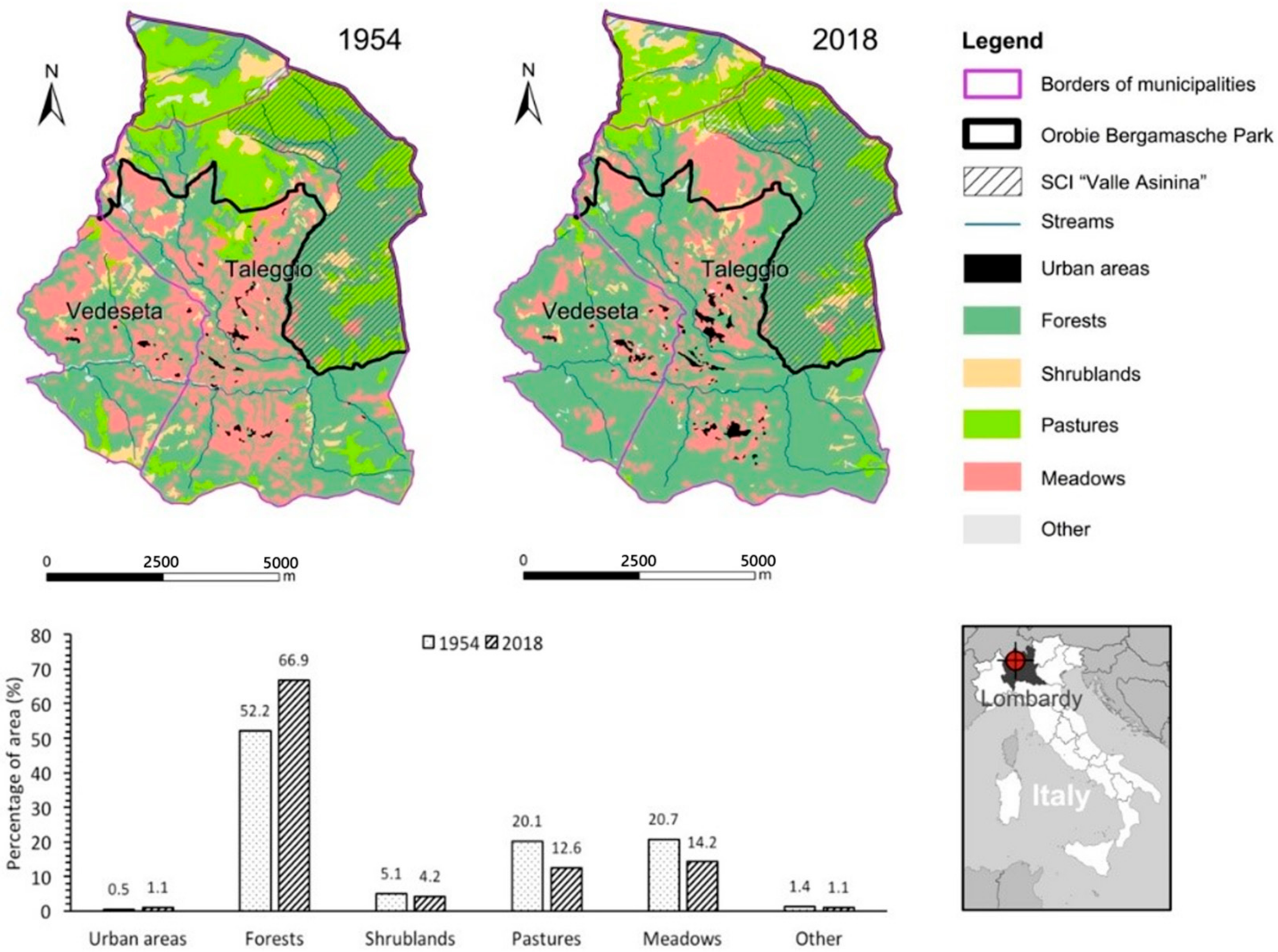
2.2. Vegetation Sampling
- A—meadows: grasslands regularly mowed (from one to three times a year) and manured once a year for the past 10 years or more;
- B—meadows-pastures: grasslands that have been managed as meadows (mowed and manured) or pastures (grazed by cattle) alternatively for at least five years or that are regularly mowed once a year (on May–June) and then grazed (August–September);
- C—pastures: grasslands, with the occasional presence of small shrubs that have been grazed by cattle for more than ten years;
- D—shrublands: areas dominated by shrubs grown where grasslands have not been managed for at least five years;
- E—forests: vegetation dominated by woody species (trees cover over 60%), Fagus sylvatica (beech) in particular, managed to produce firewood or unmanaged (current potential vegetation [27]).
2.3. Ecological Indices and Data Analysis
3. Results and Discussion
3.1. Floristic and Ecological Features
3.2. VegeT
4. Conclusions
Supplementary Materials
Author Contributions
Funding
Acknowledgments
Conflicts of Interest
Appendix A
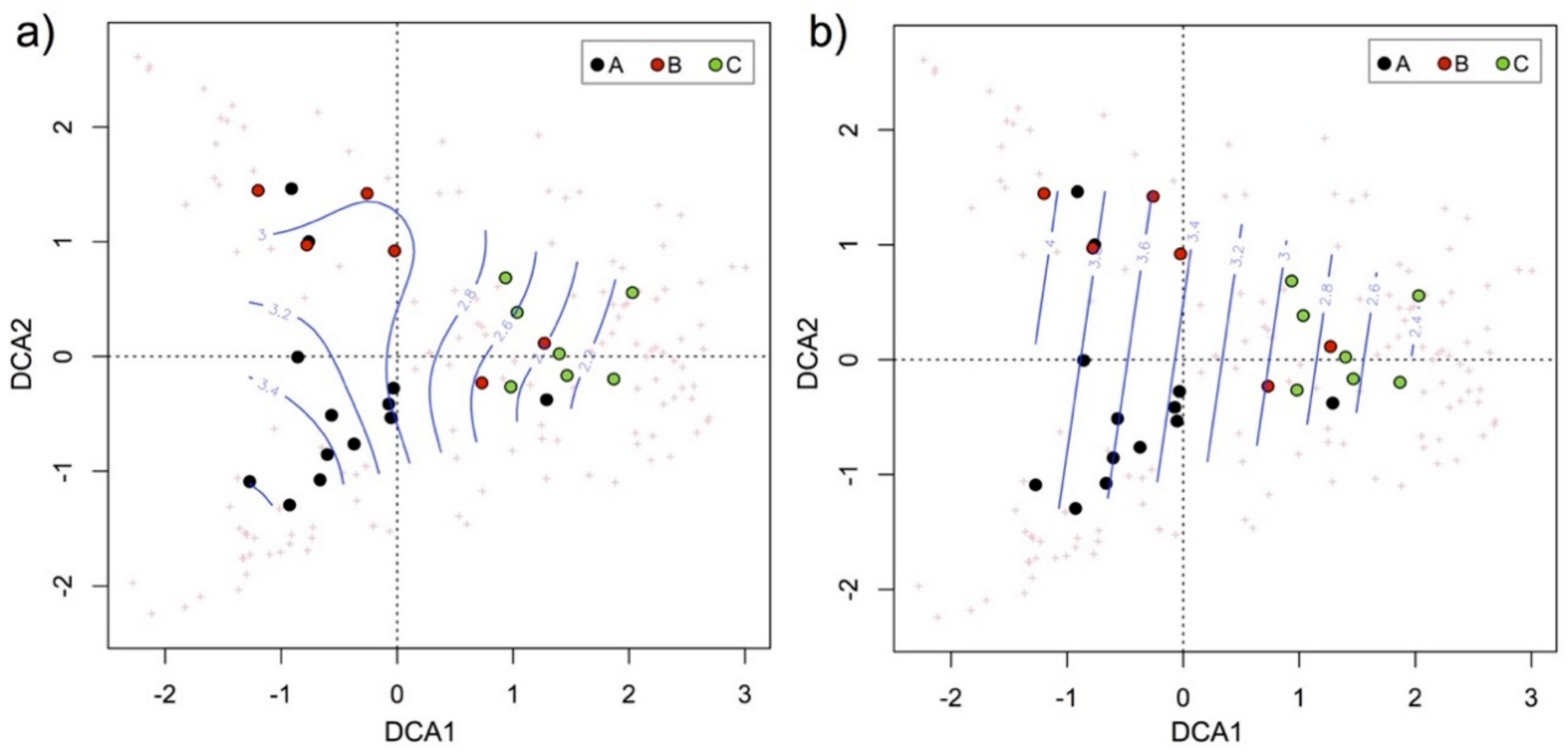
References
- Körner, C. Alpine Plant Life: Functional Plant Ecology of High Mountain Ecosystems; Springer: Berlin, Germany, 2003. [Google Scholar]
- Bucher, R.; Andres, C.; Wedel, M.F.; Entling, M.H.; Nickel, H. Biodiversity in low-intensity pastures, straw meadows, and fallows of a fen area—A multitrophic comparison. Agric. Ecosyst. Environ. 2016, 219, 190–196. [Google Scholar] [CrossRef]
- Pierik, M.E.; Gusmeroli, F.; Della Marianna, G.; Tamburini, A.; Bocchi, S. Meadows species composition, biodiversity and forage value in an Alpine district: Relationships with environmental and dairy farm management variables. Agric. Ecosyst. Environ. 2017, 244, 14–21. [Google Scholar] [CrossRef]
- Ceballos, G.; Davidson, A.; List, R.; Pacheco, J.; Manzano-Fischer, P.; Santos-Barrera, G.; Cruzado, J. Rapid Decline of a Grassland System and Its Ecological and Conservation Implications. PLoS ONE 2010, 5, e8562. [Google Scholar] [CrossRef] [PubMed] [Green Version]
- Pruchniewicz, D. Abandonment of traditionally managed mesic mountain meadows affects plant species composition and diversity. Basic Appl. Ecol. 2017, 20, 10–18. [Google Scholar] [CrossRef]
- Tarolli, P.; Straffelini, E. Agriculture in Hilly and Mountainous Landscapes: Threats, Monitoring and Sustainable Management. Geogr. Sustain. 2020, 1, 70–76. [Google Scholar] [CrossRef]
- Körber-Grohne, U. Gramineen und Grünlandvegetation vom Neolithikum bis zum Mittelalter in Mitteleuropa. Bibl. Bot. 1990, 139, 1–105. [Google Scholar]
- Körber-Grohne, U. Urwiesen im Berg und Hügelland aus archäobotanischer Sicht. Diss. Bot. 1993, 196, 453–468. [Google Scholar]
- Gusmeroli, F. Prati, Pascoli e Paesaggio Alpino; SoZooAlp: San Michele all’Adige, Italy, 2012. [Google Scholar]
- Leuschner, C.; Ellenberg, H. Ecology of Central European Non-Forest Vegetation: Coastal to Alpine, Natural to Man-Made Habitats; Springer Science and Business Media LLC: Berlin/Heidelberg, Germany, 2017. [Google Scholar]
- Bouton, Y.; Leys, B.; Ferrez, Y.; Manneville, V.; Mouly, A.; Greffier, B.; Hennequin, C.; Bouton, Y.; Prévost-Bouré, N.C.; Gillet, F. Towards the assessment of biodiversity and management practices in mountain pastures using diagnostic species? Ecol. Indic. 2019, 107, 105584. [Google Scholar] [CrossRef]
- Nordregio. Mountain Areas in Europe: Analysis of Mountain Areas in EU Member States, Acceding and Other European Countries. Commissioned Report by the European Commission; DG Regional Policy: Brussels, Belgium, 2004. [Google Scholar]
- Macdonald, D.; Crabtree, J.; Wiesinger, G.; Dax, T.; Stamou, N.; Fleury, P.; Lazpita, J.G.; Gibon, A. Agricultural abandonment in mountain areas of Europe: Environmental consequences and policy response. J. Environ. Manag. 2000, 59, 47–69. [Google Scholar] [CrossRef]
- Keenleyside, C.; Tucker, G.M. Farmland Abandonment in the EU: An Assessment of Trends and Prospects Report Prepared for WWF; Institute for European Environmental Policy: London, UK, 2010. [Google Scholar]
- Terres, J.M.; Nisini, L.; Anguiano, E. Assessing the Risk of Farmland Abandonment in the EU. Final Report EUR 25783EN; Joint Research Centre of the European Commission: Brussels, Belgium, 2013.
- Targetti, S.; Staglianò, N.; Messeri, A.; Argenti, G. A state-and-transition approach to alpine grasslands under abandonment. iForest Biogeosci. For. 2010, 3, 44–51. [Google Scholar] [CrossRef] [Green Version]
- Monteiro, A.; Fava, F.; Hiltbrunner, E.; Della Marianna, G.; Bocchi, S. Assessment of land cover changes and spatial drivers behind loss of permanent meadows in the lowlands of Italian Alps. Landsc. Urban Plan. 2011, 100, 287–294. [Google Scholar] [CrossRef]
- Cislaghi, A.; Giupponi, L.; Tamburini, A.; Giorgi, A.; Bischetti, G.B. The effects of mountain grazing abandonment on plant community, forage value and soil properties: Observations and field measurements in an alpine area. Catena 2019, 181, 104086. [Google Scholar] [CrossRef]
- Loidi, J. Dynamism in vegetation. Vegetation changes on a short time scale. In The Vegetation of the Iberian Peninsula; Loidi, J., Ed.; Springer: Cham, Switzerland, 2017; pp. 81–99. [Google Scholar]
- Prach, K.; Walker, L.R. Differences between primary and secondary plant succession among biomes of the world. J. Ecol. 2018, 107, 510–516. [Google Scholar] [CrossRef]
- Tscharntke, T.; Klein, A.M.; Kruess, A.; Steffan-Dewenter, I.; Thies, C. Landscape perspectives on agricultural intensification and biodiversity †ecosystem service management. Ecol. Lett. 2005, 8, 857–874. [Google Scholar] [CrossRef]
- Niedrist, G.; Tasser, E.; Lüth, C.; Via, J.D.; Tappeiner, U. Plant diversity declines with recent land use changes in European Alps. Plant Ecol. 2009, 202, 195–210. [Google Scholar] [CrossRef]
- Chiesa, L.; Labella, G.; Giorgi, A.; Panseri, S.; Pavlovic, R.; Bonacci, S.; Arioli, F. The occurrence of pesticides and persistent organic pollutants in Italian organic honeys from different productive areas in relation to potential environmental pollution. Chemosphere 2016, 154, 482–490. [Google Scholar] [CrossRef]
- Lakner, S.; Zinngrebe, Y.; Koemle, D. Combining management plans and payment schemes for targeted grassland conservation within the Habitats Directive in Saxony, Eastern Germany. Land Use Policy 2020, 97, 104642. [Google Scholar] [CrossRef]
- Luoni, F.; Rossi, P.; Celada, C. Programmi di Sviluppo Rurale 2014–2020 Delle Regioni Lombardia e Piemonte e Biodiversità: Un Approccio Analitico. Lipu, WWF, Legambiente; FAI: Milan, Italy, 2018. [Google Scholar]
- Argenti, G.; Lombardi, G. The pasture-type approach for mountain pasture description and management. Ital. J. Agron. 2012, 7, 39. [Google Scholar] [CrossRef] [Green Version]
- Biondi, E. Phytosociology today: Methodological and conceptual evolution. Plant Biosyst. Int. J. Deal. Asp. Plant Biol. 2011, 145, 19–29. [Google Scholar] [CrossRef]
- Dengler, J.; Chytry, M.; Ewald, J. Phytosociology; Elsevier BV: Amsterdam, The Netherlands, 2008; pp. 2767–2779. [Google Scholar]
- Pagliacci, F.; Pavone, P.; Russo, M.; Giorgi, A. Regional structural heterogeneity: Evidence and policy implications for RIS3 in macro-regional strategies. Reg. Stud. 2019, 54, 765–775. [Google Scholar] [CrossRef]
- Giupponi, L.; Giorgi, A. Mount Cavallo Botanical Path: A proposal for the valorization of an area of the Orobie Bergamasche Regional Park (Southern Alps). Eco. Mont 2017, 9, 5–15. [Google Scholar] [CrossRef] [Green Version]
- Giupponi, L.; Giorgi, A. A contribution to the knowledge of Linaria tonzigii Lona, a steno-endemic species of the Orobie Bergamasche Regional Park (Italian Alps). Eco. Mont 2019, 11, 16–24. [Google Scholar] [CrossRef] [Green Version]
- ISTAT—National Institute of Statistics. Bilancio Demografico Anno 2018. Available online: http://demo.istat.it/bilmens2018gen/index.html (accessed on 20 August 2020).
- RGDB—Regional Geographical Database. Geographical Database of Regione Lombardia. 2018. Available online: http://www.geoportale.regione.lombardia.it (accessed on 20 August 2020).
- Bergamo Province. Carta Geologica Della Provincia di Bergamo; Grafica Monti s.n.c.: Bergamo, Italy, 2002. [Google Scholar]
- Rivas-Martínez, S.; Penas, A.; Díaz, T.E. Biogeographic map of Europe. 2004. Available online: http://www.globalbioclimatics.org/form/maps.htm (accessed on 20 August 2020).
- Andreis, C. I distretti geobotanici. In I Tipi Forestali della Lombardia; Del Favero, R., Ed.; Cierre: Verona, Italy, 2002; pp. 36–40. [Google Scholar]
- Di Blasi, C.; Capotorti, G.; Copiz, R.; Guida, D.; Mollo, B.; Smiraglia, D.; Zavattero, L. Classification and mapping of the ecoregions of Italy. Plant Biosyst. Int. J. Deal. Asp. Plant Biol. 2014, 148, 1255–1345. [Google Scholar] [CrossRef]
- Del Favero, R. I Tipi Forestali della Lombardia; Cierre: Verona, Italy, 2002. [Google Scholar]
- Verde, S.; Assini, S.; Andreis, C. Le serie di vegetazione della regione Lombardia. In La Vegetazione d’Italia; Blasi, C., Ed.; Palombi and Partner, S.r.l: Roma, Italy, 2010; pp. 181–203. [Google Scholar]
- Braun-Blanquet, J. Pflanzensoziologie; Springer Science and Business Media LLC: Berlin/Heidelberg, Germany, 1964. [Google Scholar]
- Pignatti, S. Flora d’Italia; Edagricole: Bologna, Italy, 2017. [Google Scholar]
- Canullo, R.; Allegrini, M.C.; Campetella, G. Reference field manual for vegetation surveys on the Conecofor Lii network, Italy (National Programme of Forest Ecosystems Control—Unece, ICP Forests). Braun-Blanquetia 2012, 48, 5–65. [Google Scholar]
- Biondi, E.; Blasi, C. Prodromo Della Vegetazione d’Italia. 2015. Available online: http://www.prodromo-vegetazione-italia.org (accessed on 20 August 2020).
- Landolt, E. Ökologische Zeigerwerte zur Schweizer Flora; Geobotanisch Institut ETH: Zurich, Switzerland, 1977. [Google Scholar]
- Landolt, E.; Bäumler, B.; Erhardt, A.; Hegg, O.; Klötzli, F.; Lämmle, R.W.; Nobis, M.; Rudmann-Maurer, K.; Schweingruber, F.H.; Theurillat, J.-P.; et al. Flora Indicative: Ecological Indicator Values and Biological Attributes of the Flora of Switzerland and the Alps; Haupt Verlag: Bern, Switzerland; Stuttgart, Germany; Wien, Austria, 2010. [Google Scholar]
- Tukey, J.W. On the Comparative Anatomy of Transformations. Ann. Math. Stat. 1957, 28, 602–632. [Google Scholar] [CrossRef]
- R Core Team. R: A Language and Environment for Statistical Computing; R Foundation for Statistical Computing: Vienna, Austria, 2018. [Google Scholar]
- Stachurska-Swakon, A. Synanthropic communities with Rumex alpinus in the Tatra National Park (Western Carpathians). Scr. Fac. Rerum Nat. Ostrav. 2008, 186, 321–330. [Google Scholar]
- Schmid, R.; Aeschimann, D.; Lauber, K.; Moser, D.M.; Theurillat, J.-P.; Price, M. Flora Alpina: Atlas des 4500 Plantes Vascularies des Alpes. TAXON 2005, 54, 843. [Google Scholar] [CrossRef]
- Giupponi, L.; Pentimalli, D.; Manzo, A.; Panseri, S.; Giorgi, A. Effectiveness of fine root fingerprinting as a tool to identify plants of the Alps: Results of a preliminary study. Plant Biosyst. Int. J. Deal. Asp. Plant Biol. 2017, 152, 464–473. [Google Scholar] [CrossRef]
- Mucina, L.; Grabherr, G.; Ellmauer, T.; Wallnöfer, S. Die Pfanzengesellschaften Österreichs; Gustav Fischer Verlag: Jena, Germany, 1993. [Google Scholar]
- Biondi, E.; Di Blasi, C.; Allegrezza, M.; Anzellotti, I.; Azzella, M.M.; Carli, E.; Casavecchia, S.; Copiz, R.; Del Vico, E.; Facioni, L.; et al. Plant communities of Italy: The Vegetation Prodrome. Plant Biosyst. Int. J. Deal. Asp. Plant Biol. 2014, 148, 728–814. [Google Scholar] [CrossRef] [Green Version]
- Pignatti, E.; Pignatti, S. Plant Life of the Dolomites; Springer Science and Business Media LLC: Berlin/Heidelberg, Germany, 2016. [Google Scholar]
- Scotton, M.; Sicher, L.; Kasal, A. Semi-natural grasslands of the Non Valley (Eastern Italian Alps): Agronomic and environmental value of traditional and new Alpine hay-meadow types. Agric. Ecosyst. Environ. 2014, 197, 243–254. [Google Scholar] [CrossRef]
- Briemble, G.; Ellenberg, H. Zur Mahdverträglichkeit von Grünlandpflanzen. Möglichkeiten der praktischen Anwendung von Zeigerwerten. Nat. Landsch. 1994, 69, 139–147. [Google Scholar]
- Briemble, G.; Nitsche, S.; Nitsche, L. Nutzungswertzahlen für gefässpflanzen des grünlandes. In Biolflor–Eine Datenbank Mit Biologisch-Ökologischen Merkmalen zur Flora von Deutschland; Klotz, S., Kuhn, I., Figa, B., Durka, W., Eds.; Landwirtschaftsverlag: Zurich, Switzerland, 2002; pp. 203–225. [Google Scholar]
- Argenti, G.; Staglianò, N.; Bellini, E.; Messeri, A.; Targetti, S. Environmental and management drivers of alpine grassland vegetation types. Ital. J. Agron. 2020, 15, 156–164. [Google Scholar] [CrossRef]
- Rivas-Martinez, S. Notions on dynamic-catenal phytosociology as a basis of landscape science. Plant Biosyst. Int. J. Deal. Asp. Plant Biol. 2005, 139, 135–144. [Google Scholar] [CrossRef]
- Van Der Maabel, E. Transformation of cover-abundance values in phytosociology and its effects on community similarity. Plant Ecol. 1979, 39, 97–114. [Google Scholar] [CrossRef]
- Van Der Maarel, E. Transformation of cover-abundance values for appropriate numerical treatment—Alternatives to the proposals by Podani. J. Veg. Sci. 2007, 18, 767–770. [Google Scholar] [CrossRef]
- Whittaker, R.H. Evolution and Measurement of Species Diversity. TAXON 1972, 21, 213–251. [Google Scholar] [CrossRef] [Green Version]
- Häupler, H. Evenness Als Ausdruck der Vielfalt in der Vegetation; Cramer: Vaduz, Liechtenstein, 1982. [Google Scholar]
- Ewald, J. A critique for phytosociology. J. Veg. Sci. 2003, 14, 291–296. [Google Scholar] [CrossRef]
- Chytrý, M.; Tichý, L.; Hennekens, S.M.; Knollová, I.; Janssen, J.A.M.; Rodwell, J.S.; Peterka, T.; Marcenò, C.; Landucci, F.; Danihelka, J.; et al. EUNIS Habitat Classification: Expert system, characteristic species combinations and distribution maps of European habitats. Appl. Veg. Sci. 2020, 1–28. [Google Scholar] [CrossRef]
- Rojo, M.P.R.; Font, X.; García-Mijangos, I.; Crespo, G.; Fernández-González, F. An expert system as an applied tool for the conservation of semi-natural grasslands on the Iberian Peninsula. Biodivers. Conserv. 2020, 29, 1977–1992. [Google Scholar] [CrossRef]
- Berauer, B.J.; Wilfahrt, P.A.; Reu, B.; Schuchardt, M.A.; Garcia-Franco, N.; Zistl-Schlingmann, M.; Dannenmann, M.; Kiese, R.; Kühnel, A.; Jentsch, A. Predicting forage quality of species-rich pasture grasslands using vis-NIRS to reveal effects of management intensity and climate change. Agric. Ecosyst. Environ. 2020, 296, 106929. [Google Scholar] [CrossRef]
- Gao, X.; Dong, S.; Li, S.; Xu, Y.; Liu, S.; Zhao, H.; Yeomans, J.; Li, Y.; Shen, H.; Wu, S.; et al. Using the random forest model and validated MODIS with the field spectrometer measurement promote the accuracy of estimating aboveground biomass and coverage of alpine grasslands on the Qinghai-Tibetan Plateau. Ecol. Indic. 2020, 112, 106114. [Google Scholar] [CrossRef]
- Lyu, X.; Li, X.; Dang, D.; Dou, H.; Xuan, X.; Liu, S.; Li, M.; Gong, J. A new method for grassland degradation monitoring by vegetation species composition using hyperspectral remote sensing. Ecol. Indic. 2020, 114, 106310. [Google Scholar] [CrossRef]
- Giorgi, A.; Scheurer, T. Alpine Resources: Assets for a Promising Future—Conclusions from the ForumAlpinum 2014. Mt. Res. Dev. 2015, 35, 414–415. [Google Scholar] [CrossRef]
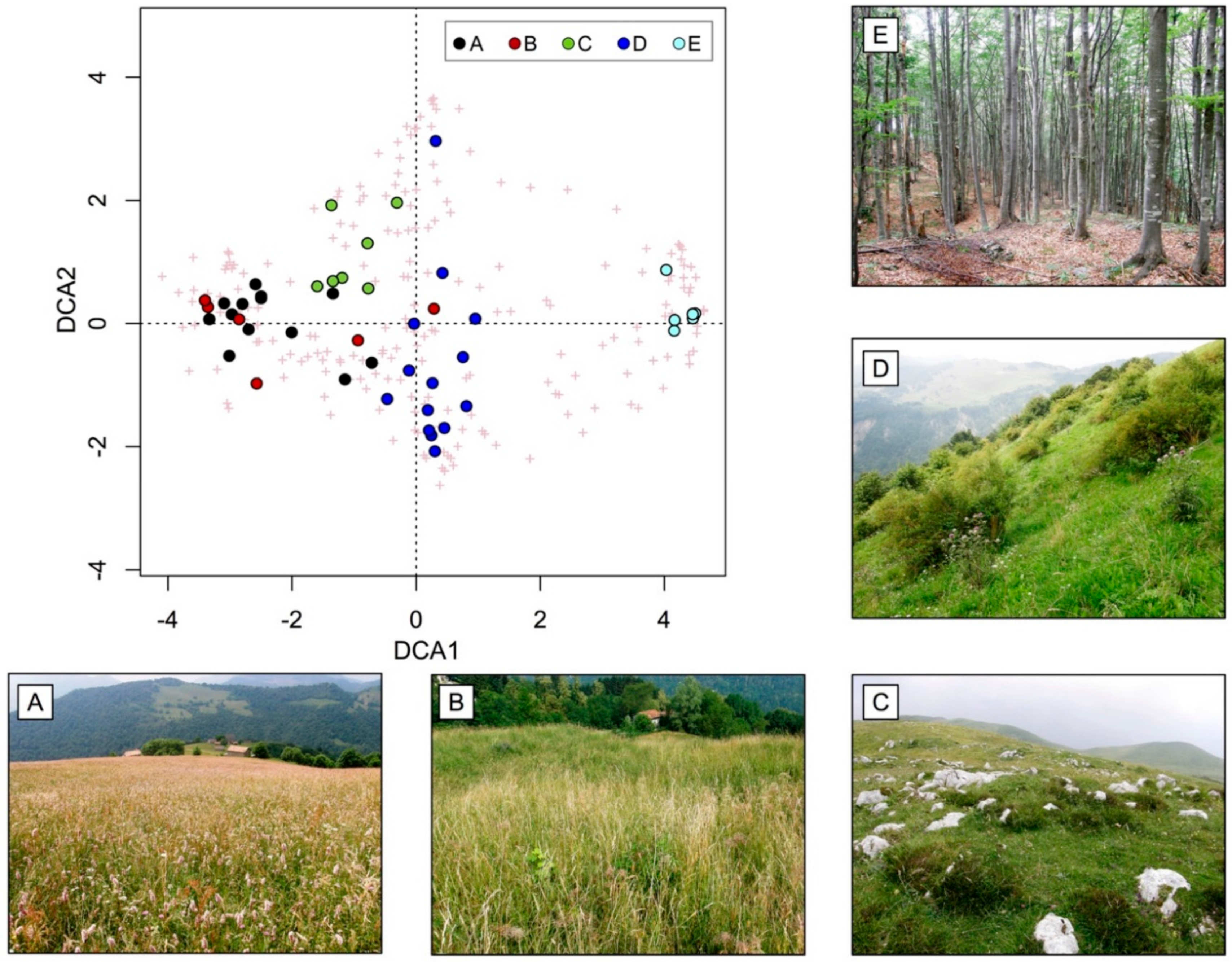
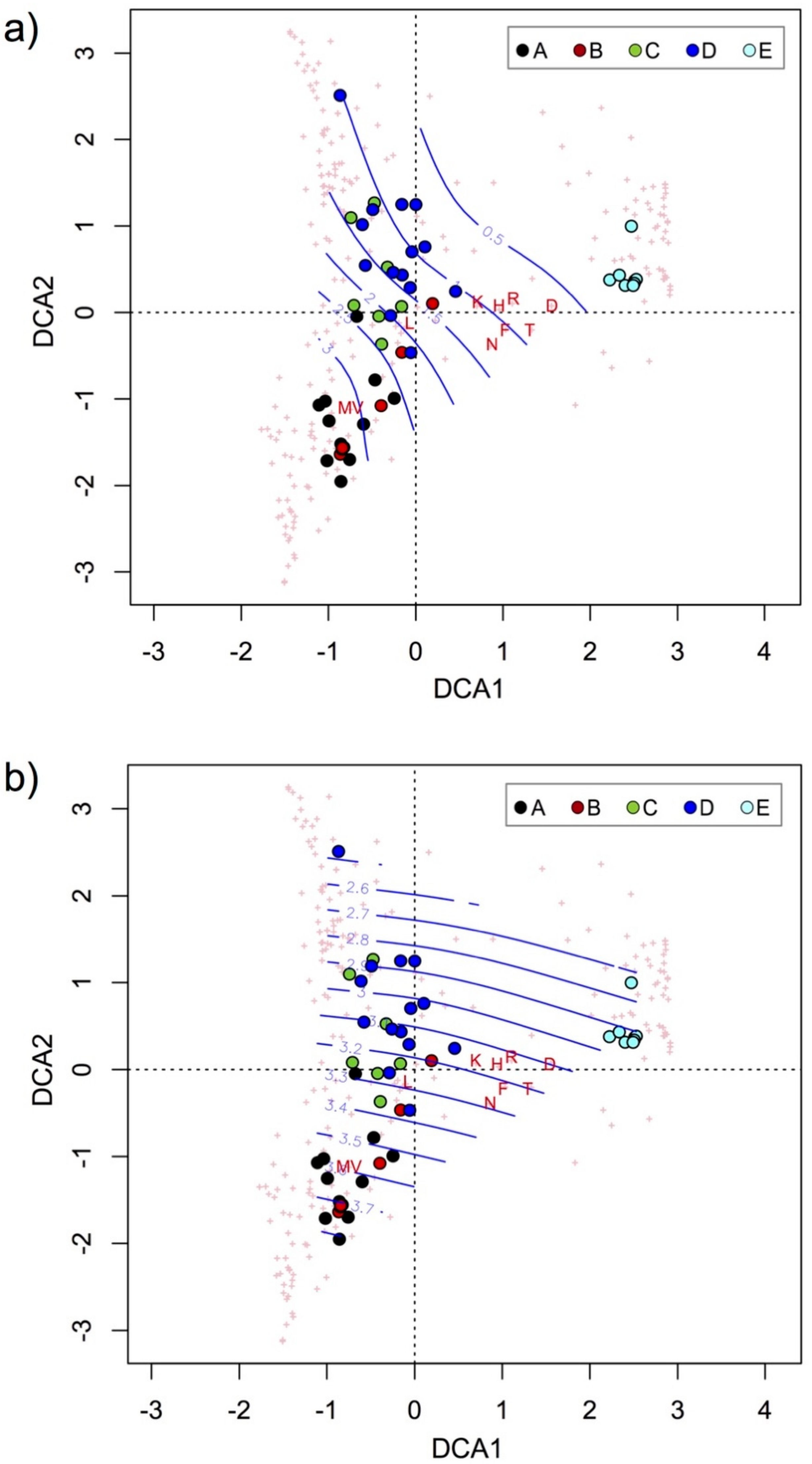
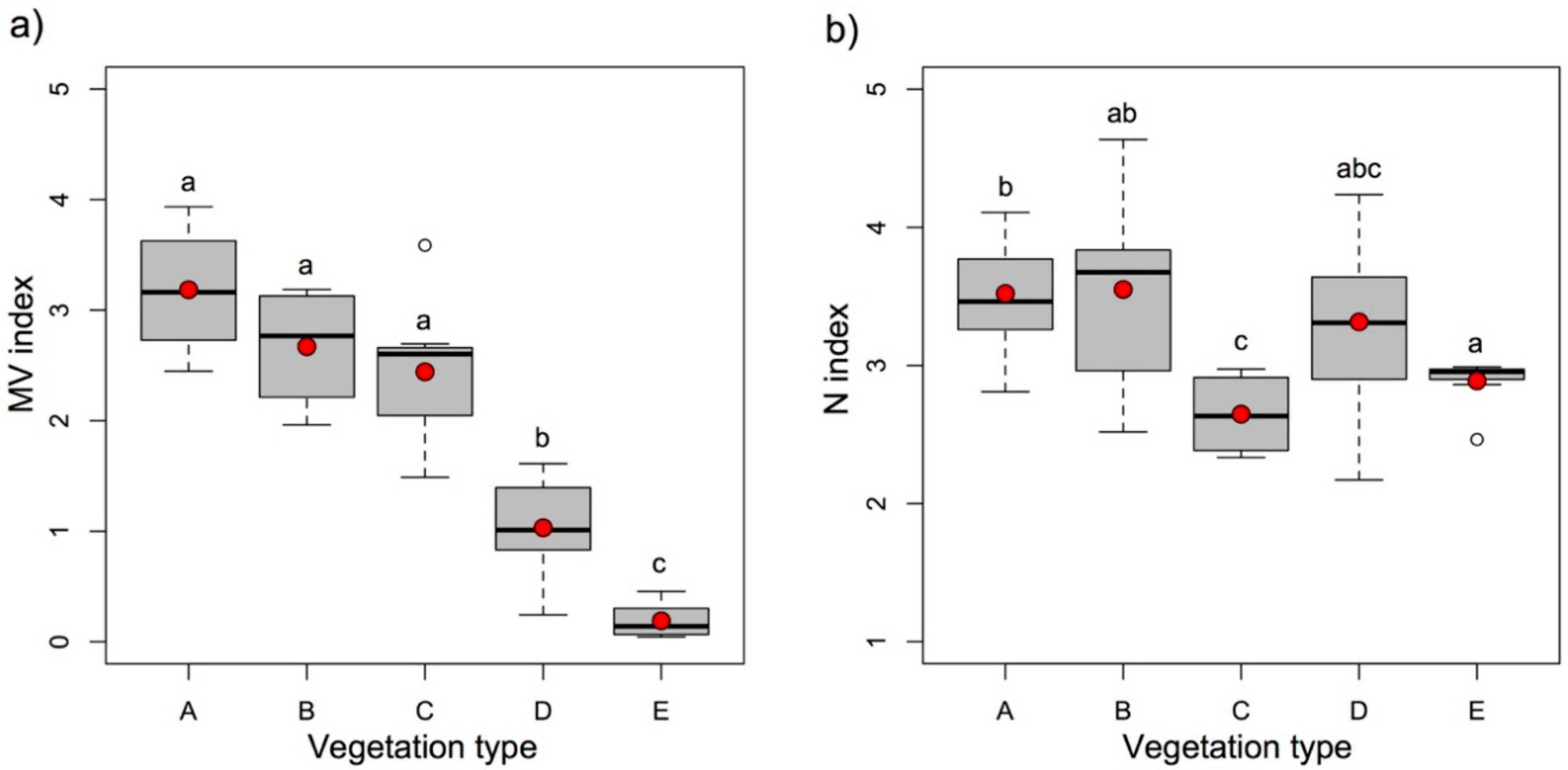
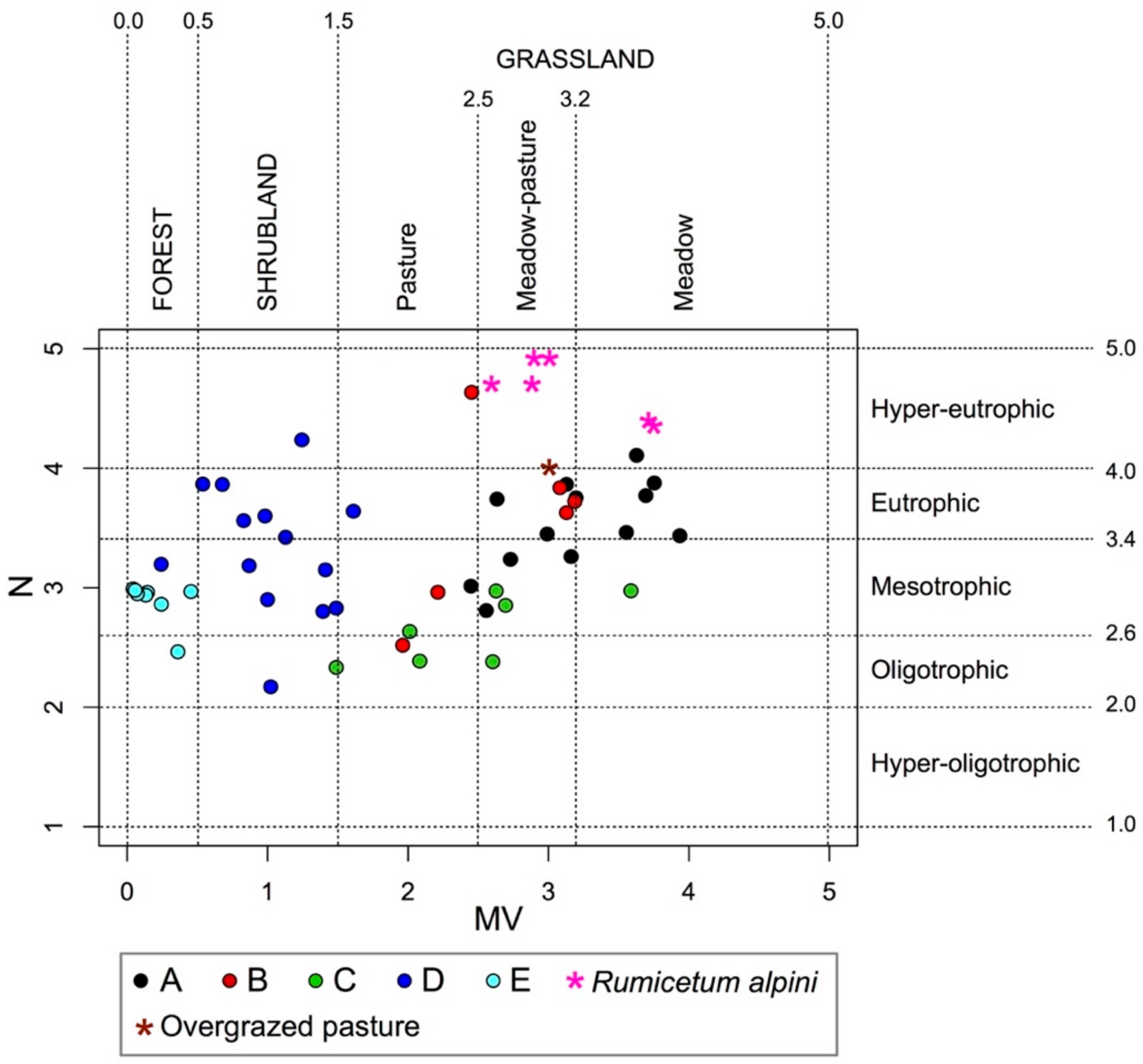
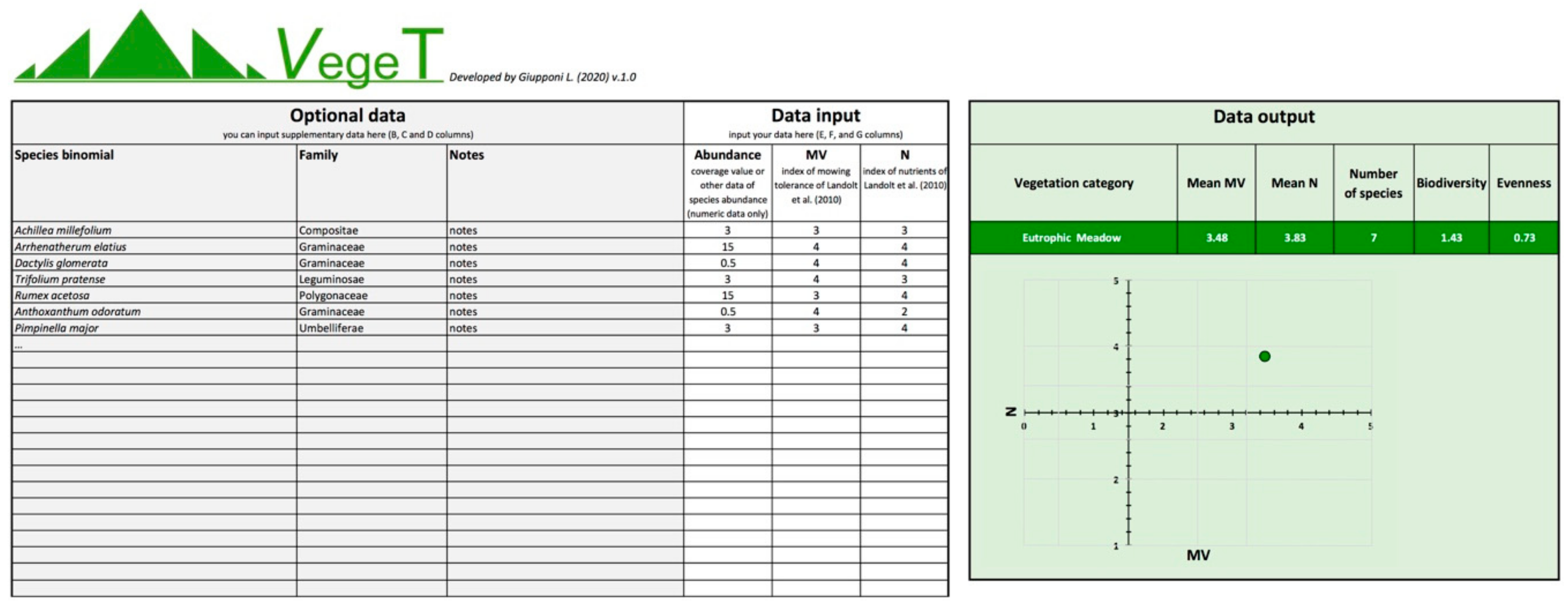
| Abundance/Dominance Indexes of Braun-Blanquet | Plant Coverage | Transformation Values of Abundance/Dominance Indexes |
|---|---|---|
| r | rare species in the relevés | 0.01% |
| + | <1% | 0.50% |
| 1 | 1%–5% | 3.00% |
| 2 | 6%–25% | 15.00% |
| 3 | 26%–50% | 37.50% |
| 4 | 51%–75% | 62.50% |
| 5 | 76%–100% | 87.50% |
| Source of Variance | Mean Square | F4,43 | p | |
|---|---|---|---|---|
| T | 0.55 | 14.99 | <0.01 | * |
| K | 0.71 | 7.91 | <0.01 | * |
| L | 7.71 | 54.56 | <0.01 | * |
| F | 0.11 | 1.73 | 0.16 | ns |
| R | 0.03 | 0.23 | 0.91 | ns |
| N | 1.06 | 4.67 | <0.01 | * |
| H | 0.16 | 1.14 | 0.35 | ns |
| D | 1.21 | 8.39 | <0.01 | * |
| MV | 14.63 | 54.01 | <0.01 | * |
Publisher’s Note: MDPI stays neutral with regard to jurisdictional claims in published maps and institutional affiliations. |
© 2020 by the authors. Licensee MDPI, Basel, Switzerland. This article is an open access article distributed under the terms and conditions of the Creative Commons Attribution (CC BY) license (http://creativecommons.org/licenses/by/4.0/).
Share and Cite
Giupponi, L.; Leoni, V. VegeT: An Easy Tool to Classify and Facilitate the Management of Seminatural Grasslands and Dynamically Connected Vegetation of the Alps. Land 2020, 9, 473. https://doi.org/10.3390/land9120473
Giupponi L, Leoni V. VegeT: An Easy Tool to Classify and Facilitate the Management of Seminatural Grasslands and Dynamically Connected Vegetation of the Alps. Land. 2020; 9(12):473. https://doi.org/10.3390/land9120473
Chicago/Turabian StyleGiupponi, Luca, and Valeria Leoni. 2020. "VegeT: An Easy Tool to Classify and Facilitate the Management of Seminatural Grasslands and Dynamically Connected Vegetation of the Alps" Land 9, no. 12: 473. https://doi.org/10.3390/land9120473





